University Research Project: Dyslexia Misrepresentation in Singapore
VerifiedAdded on 2022/09/09
|14
|3871
|34
Report
AI Summary
This research project investigates the misrepresentation of dyslexia in Singapore, focusing on the Dyslexia Association of Singapore (DAS) and its efforts to combat negative perceptions and discrimination. The project explores the biological nature of dyslexia, its impact on learning, and the societal challenges faced by individuals with the condition, including issues of labelling, stereotyping, and social exclusion. It highlights the significance of addressing these problems and promoting public awareness. The research includes a literature review of existing academic work, discussing key communication and media concepts relevant to the topic. The study aims to create awareness about the disorder and its impact and educate people about the disorder. It also examines the work of DAS in providing support and promoting research and ethical considerations for helping the children suffering from the disorder. The project emphasizes the need for understanding, acceptance, and integration of dyslexic individuals within society.
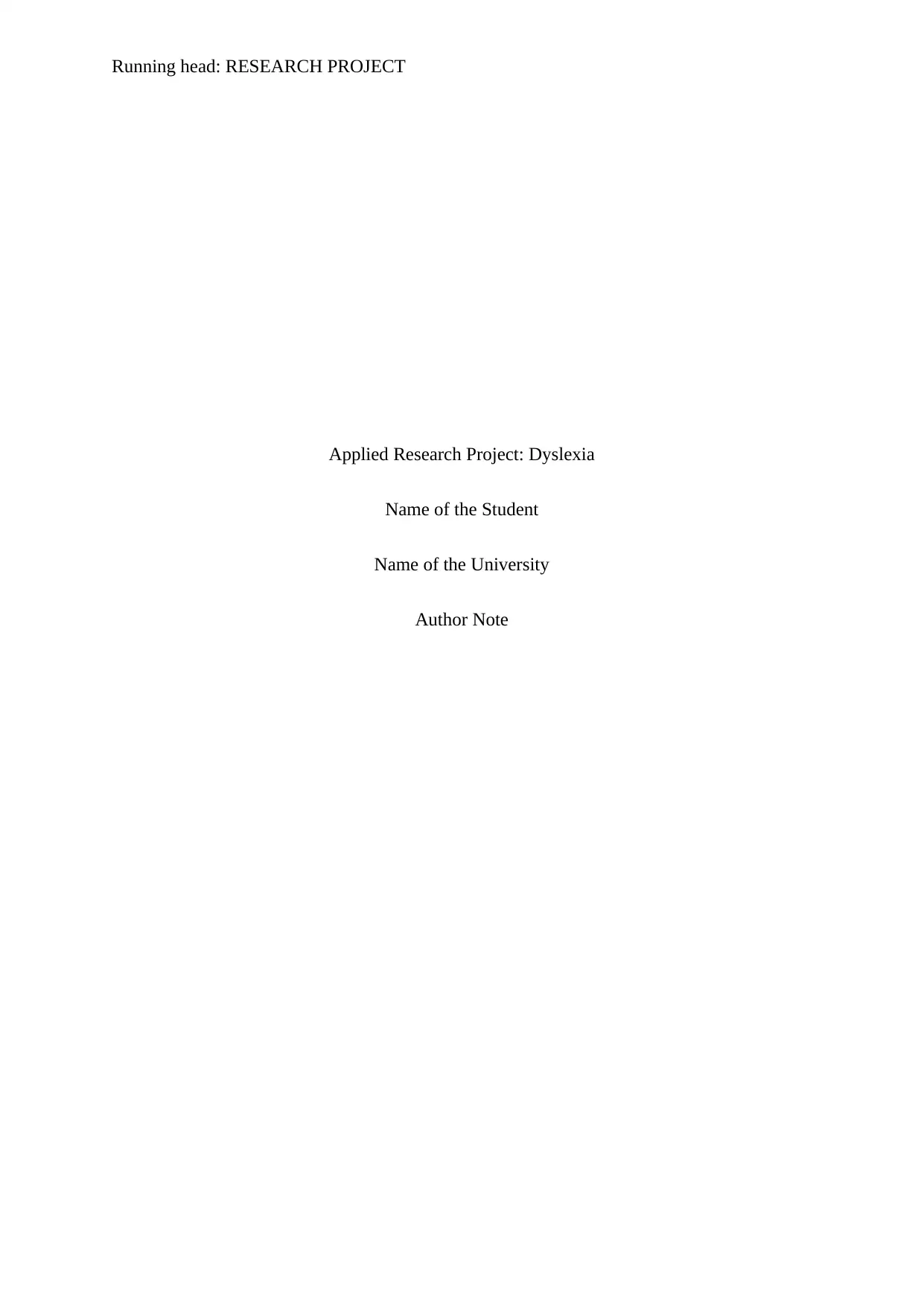
Running head: RESEARCH PROJECT
Applied Research Project: Dyslexia
Name of the Student
Name of the University
Author Note
Applied Research Project: Dyslexia
Name of the Student
Name of the University
Author Note
Paraphrase This Document
Need a fresh take? Get an instant paraphrase of this document with our AI Paraphraser
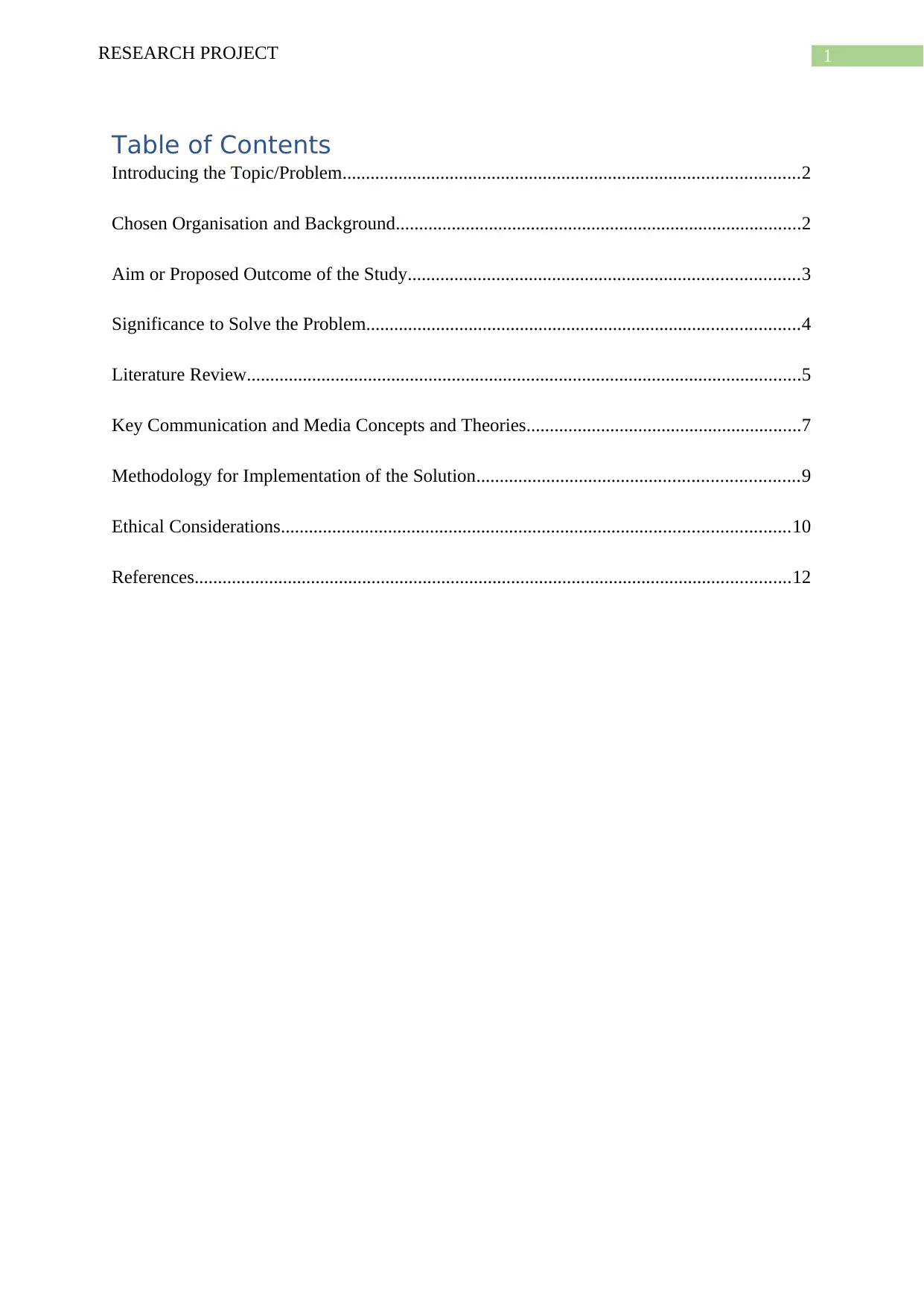
1RESEARCH PROJECT
Table of Contents
Introducing the Topic/Problem..................................................................................................2
Chosen Organisation and Background.......................................................................................2
Aim or Proposed Outcome of the Study....................................................................................3
Significance to Solve the Problem.............................................................................................4
Literature Review.......................................................................................................................5
Key Communication and Media Concepts and Theories...........................................................7
Methodology for Implementation of the Solution.....................................................................9
Ethical Considerations.............................................................................................................10
References................................................................................................................................12
Table of Contents
Introducing the Topic/Problem..................................................................................................2
Chosen Organisation and Background.......................................................................................2
Aim or Proposed Outcome of the Study....................................................................................3
Significance to Solve the Problem.............................................................................................4
Literature Review.......................................................................................................................5
Key Communication and Media Concepts and Theories...........................................................7
Methodology for Implementation of the Solution.....................................................................9
Ethical Considerations.............................................................................................................10
References................................................................................................................................12
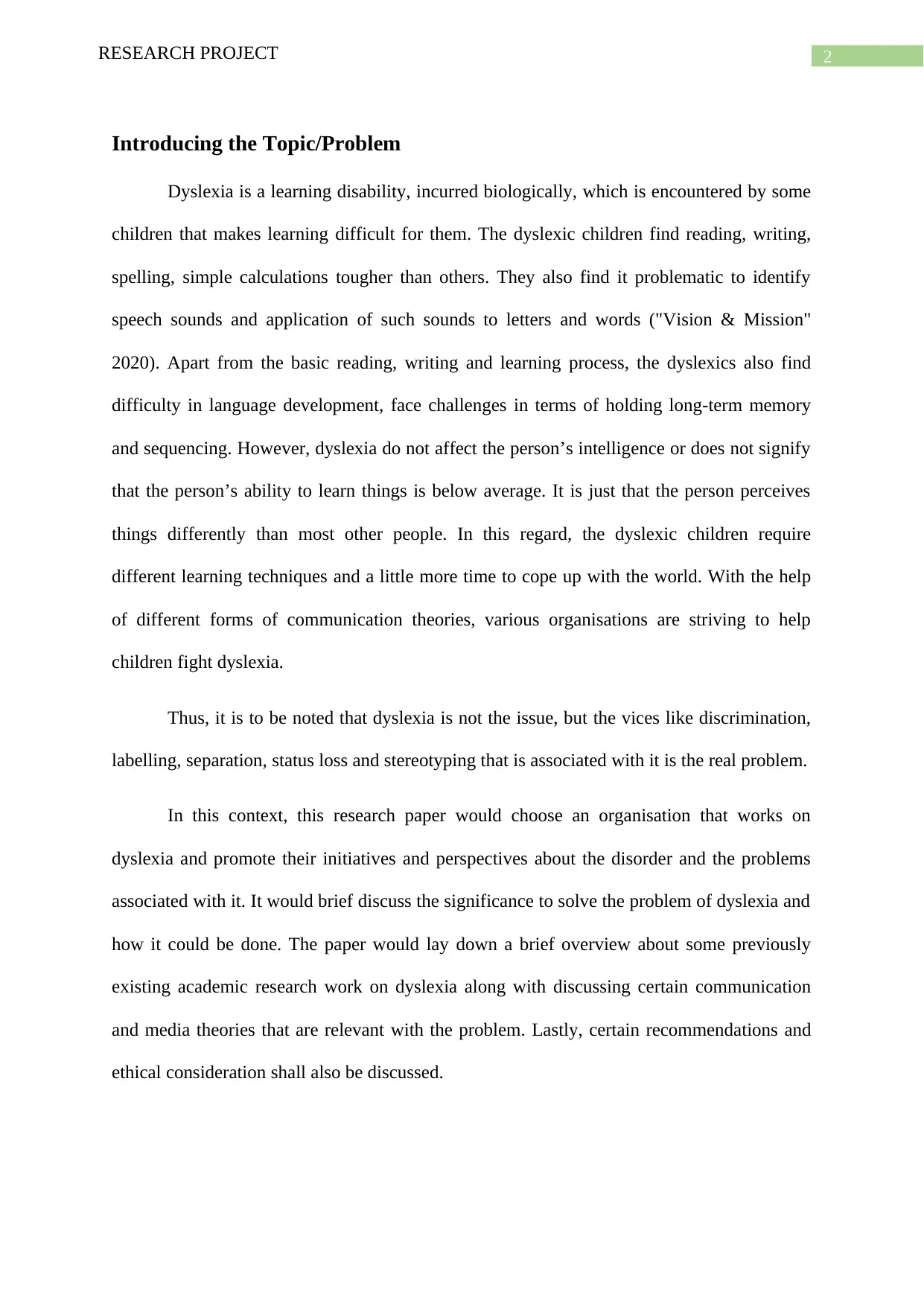
2RESEARCH PROJECT
Introducing the Topic/Problem
Dyslexia is a learning disability, incurred biologically, which is encountered by some
children that makes learning difficult for them. The dyslexic children find reading, writing,
spelling, simple calculations tougher than others. They also find it problematic to identify
speech sounds and application of such sounds to letters and words ("Vision & Mission"
2020). Apart from the basic reading, writing and learning process, the dyslexics also find
difficulty in language development, face challenges in terms of holding long-term memory
and sequencing. However, dyslexia do not affect the person’s intelligence or does not signify
that the person’s ability to learn things is below average. It is just that the person perceives
things differently than most other people. In this regard, the dyslexic children require
different learning techniques and a little more time to cope up with the world. With the help
of different forms of communication theories, various organisations are striving to help
children fight dyslexia.
Thus, it is to be noted that dyslexia is not the issue, but the vices like discrimination,
labelling, separation, status loss and stereotyping that is associated with it is the real problem.
In this context, this research paper would choose an organisation that works on
dyslexia and promote their initiatives and perspectives about the disorder and the problems
associated with it. It would brief discuss the significance to solve the problem of dyslexia and
how it could be done. The paper would lay down a brief overview about some previously
existing academic research work on dyslexia along with discussing certain communication
and media theories that are relevant with the problem. Lastly, certain recommendations and
ethical consideration shall also be discussed.
Introducing the Topic/Problem
Dyslexia is a learning disability, incurred biologically, which is encountered by some
children that makes learning difficult for them. The dyslexic children find reading, writing,
spelling, simple calculations tougher than others. They also find it problematic to identify
speech sounds and application of such sounds to letters and words ("Vision & Mission"
2020). Apart from the basic reading, writing and learning process, the dyslexics also find
difficulty in language development, face challenges in terms of holding long-term memory
and sequencing. However, dyslexia do not affect the person’s intelligence or does not signify
that the person’s ability to learn things is below average. It is just that the person perceives
things differently than most other people. In this regard, the dyslexic children require
different learning techniques and a little more time to cope up with the world. With the help
of different forms of communication theories, various organisations are striving to help
children fight dyslexia.
Thus, it is to be noted that dyslexia is not the issue, but the vices like discrimination,
labelling, separation, status loss and stereotyping that is associated with it is the real problem.
In this context, this research paper would choose an organisation that works on
dyslexia and promote their initiatives and perspectives about the disorder and the problems
associated with it. It would brief discuss the significance to solve the problem of dyslexia and
how it could be done. The paper would lay down a brief overview about some previously
existing academic research work on dyslexia along with discussing certain communication
and media theories that are relevant with the problem. Lastly, certain recommendations and
ethical consideration shall also be discussed.
⊘ This is a preview!⊘
Do you want full access?
Subscribe today to unlock all pages.

Trusted by 1+ million students worldwide
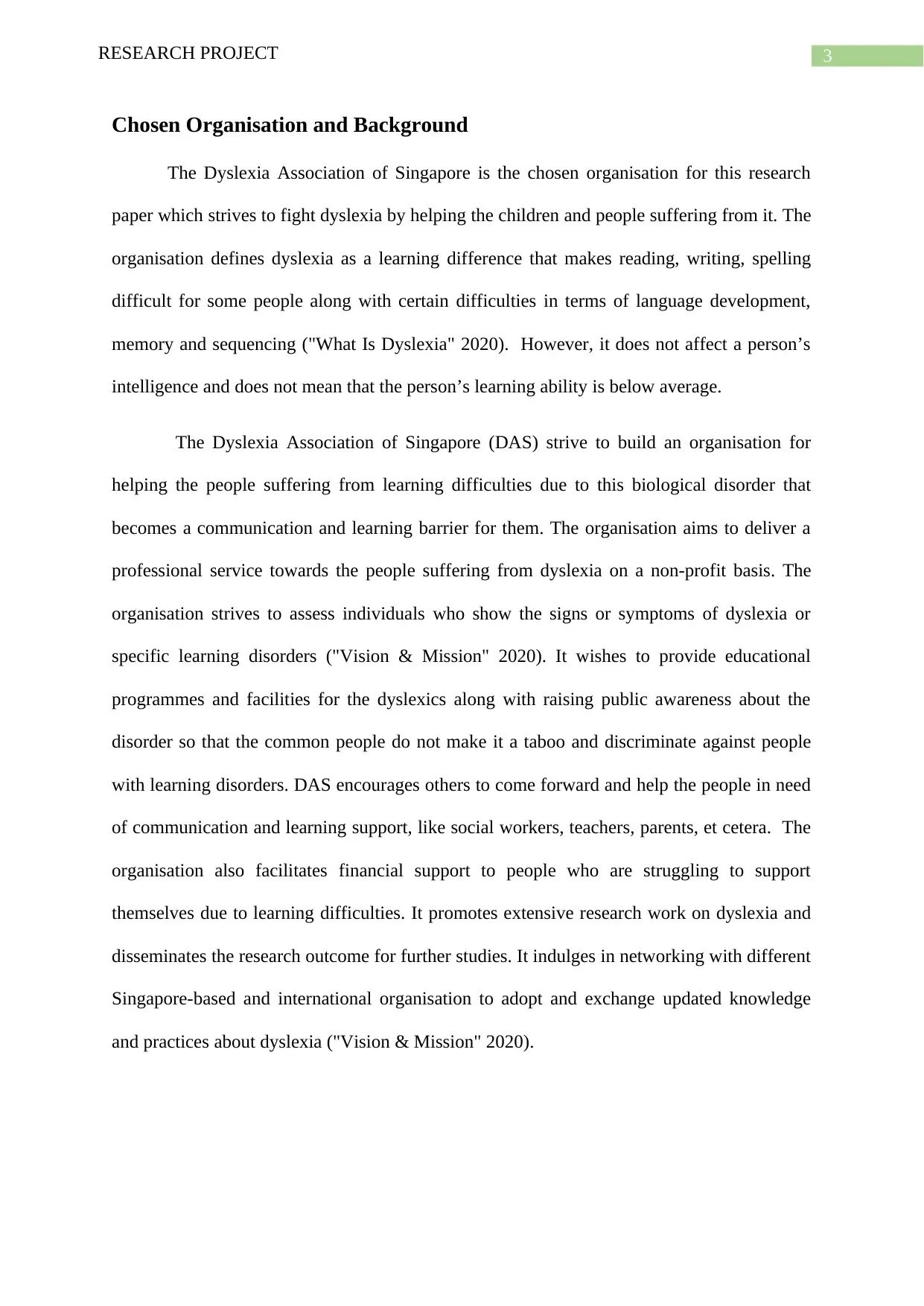
3RESEARCH PROJECT
Chosen Organisation and Background
The Dyslexia Association of Singapore is the chosen organisation for this research
paper which strives to fight dyslexia by helping the children and people suffering from it. The
organisation defines dyslexia as a learning difference that makes reading, writing, spelling
difficult for some people along with certain difficulties in terms of language development,
memory and sequencing ("What Is Dyslexia" 2020). However, it does not affect a person’s
intelligence and does not mean that the person’s learning ability is below average.
The Dyslexia Association of Singapore (DAS) strive to build an organisation for
helping the people suffering from learning difficulties due to this biological disorder that
becomes a communication and learning barrier for them. The organisation aims to deliver a
professional service towards the people suffering from dyslexia on a non-profit basis. The
organisation strives to assess individuals who show the signs or symptoms of dyslexia or
specific learning disorders ("Vision & Mission" 2020). It wishes to provide educational
programmes and facilities for the dyslexics along with raising public awareness about the
disorder so that the common people do not make it a taboo and discriminate against people
with learning disorders. DAS encourages others to come forward and help the people in need
of communication and learning support, like social workers, teachers, parents, et cetera. The
organisation also facilitates financial support to people who are struggling to support
themselves due to learning difficulties. It promotes extensive research work on dyslexia and
disseminates the research outcome for further studies. It indulges in networking with different
Singapore-based and international organisation to adopt and exchange updated knowledge
and practices about dyslexia ("Vision & Mission" 2020).
Chosen Organisation and Background
The Dyslexia Association of Singapore is the chosen organisation for this research
paper which strives to fight dyslexia by helping the children and people suffering from it. The
organisation defines dyslexia as a learning difference that makes reading, writing, spelling
difficult for some people along with certain difficulties in terms of language development,
memory and sequencing ("What Is Dyslexia" 2020). However, it does not affect a person’s
intelligence and does not mean that the person’s learning ability is below average.
The Dyslexia Association of Singapore (DAS) strive to build an organisation for
helping the people suffering from learning difficulties due to this biological disorder that
becomes a communication and learning barrier for them. The organisation aims to deliver a
professional service towards the people suffering from dyslexia on a non-profit basis. The
organisation strives to assess individuals who show the signs or symptoms of dyslexia or
specific learning disorders ("Vision & Mission" 2020). It wishes to provide educational
programmes and facilities for the dyslexics along with raising public awareness about the
disorder so that the common people do not make it a taboo and discriminate against people
with learning disorders. DAS encourages others to come forward and help the people in need
of communication and learning support, like social workers, teachers, parents, et cetera. The
organisation also facilitates financial support to people who are struggling to support
themselves due to learning difficulties. It promotes extensive research work on dyslexia and
disseminates the research outcome for further studies. It indulges in networking with different
Singapore-based and international organisation to adopt and exchange updated knowledge
and practices about dyslexia ("Vision & Mission" 2020).
Paraphrase This Document
Need a fresh take? Get an instant paraphrase of this document with our AI Paraphraser
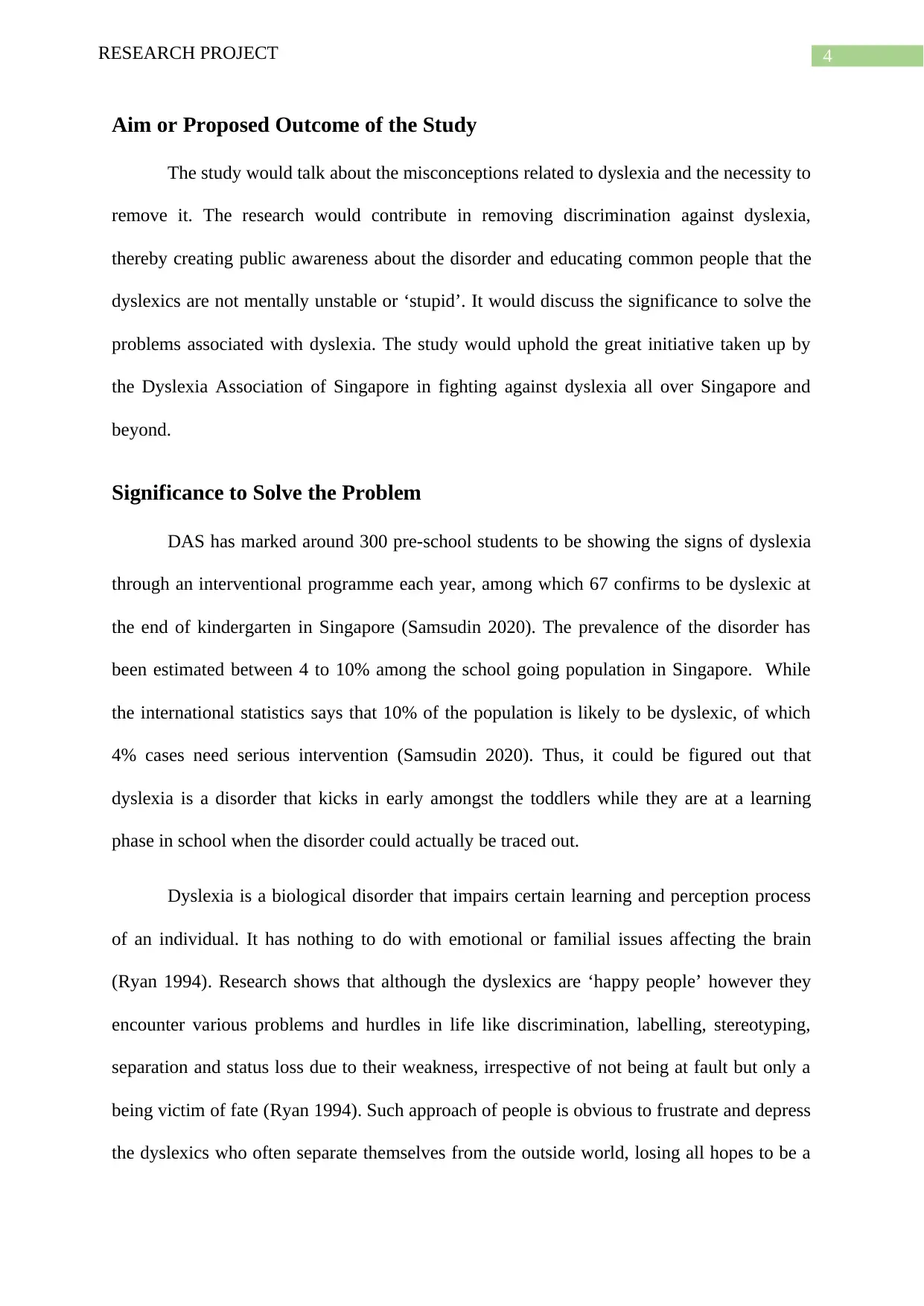
4RESEARCH PROJECT
Aim or Proposed Outcome of the Study
The study would talk about the misconceptions related to dyslexia and the necessity to
remove it. The research would contribute in removing discrimination against dyslexia,
thereby creating public awareness about the disorder and educating common people that the
dyslexics are not mentally unstable or ‘stupid’. It would discuss the significance to solve the
problems associated with dyslexia. The study would uphold the great initiative taken up by
the Dyslexia Association of Singapore in fighting against dyslexia all over Singapore and
beyond.
Significance to Solve the Problem
DAS has marked around 300 pre-school students to be showing the signs of dyslexia
through an interventional programme each year, among which 67 confirms to be dyslexic at
the end of kindergarten in Singapore (Samsudin 2020). The prevalence of the disorder has
been estimated between 4 to 10% among the school going population in Singapore. While
the international statistics says that 10% of the population is likely to be dyslexic, of which
4% cases need serious intervention (Samsudin 2020). Thus, it could be figured out that
dyslexia is a disorder that kicks in early amongst the toddlers while they are at a learning
phase in school when the disorder could actually be traced out.
Dyslexia is a biological disorder that impairs certain learning and perception process
of an individual. It has nothing to do with emotional or familial issues affecting the brain
(Ryan 1994). Research shows that although the dyslexics are ‘happy people’ however they
encounter various problems and hurdles in life like discrimination, labelling, stereotyping,
separation and status loss due to their weakness, irrespective of not being at fault but only a
being victim of fate (Ryan 1994). Such approach of people is obvious to frustrate and depress
the dyslexics who often separate themselves from the outside world, losing all hopes to be a
Aim or Proposed Outcome of the Study
The study would talk about the misconceptions related to dyslexia and the necessity to
remove it. The research would contribute in removing discrimination against dyslexia,
thereby creating public awareness about the disorder and educating common people that the
dyslexics are not mentally unstable or ‘stupid’. It would discuss the significance to solve the
problems associated with dyslexia. The study would uphold the great initiative taken up by
the Dyslexia Association of Singapore in fighting against dyslexia all over Singapore and
beyond.
Significance to Solve the Problem
DAS has marked around 300 pre-school students to be showing the signs of dyslexia
through an interventional programme each year, among which 67 confirms to be dyslexic at
the end of kindergarten in Singapore (Samsudin 2020). The prevalence of the disorder has
been estimated between 4 to 10% among the school going population in Singapore. While
the international statistics says that 10% of the population is likely to be dyslexic, of which
4% cases need serious intervention (Samsudin 2020). Thus, it could be figured out that
dyslexia is a disorder that kicks in early amongst the toddlers while they are at a learning
phase in school when the disorder could actually be traced out.
Dyslexia is a biological disorder that impairs certain learning and perception process
of an individual. It has nothing to do with emotional or familial issues affecting the brain
(Ryan 1994). Research shows that although the dyslexics are ‘happy people’ however they
encounter various problems and hurdles in life like discrimination, labelling, stereotyping,
separation and status loss due to their weakness, irrespective of not being at fault but only a
being victim of fate (Ryan 1994). Such approach of people is obvious to frustrate and depress
the dyslexics who often separate themselves from the outside world, losing all hopes to be a
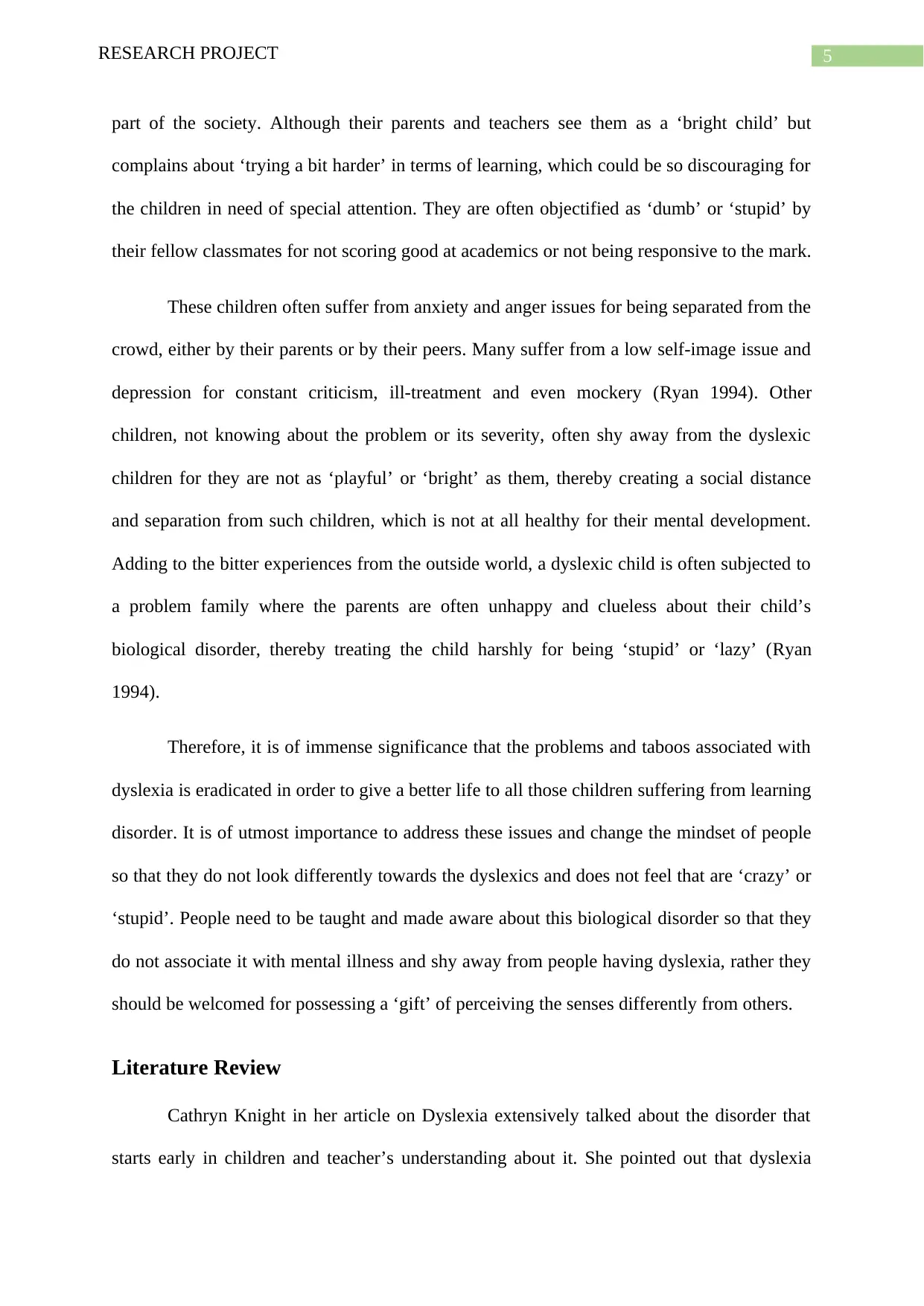
5RESEARCH PROJECT
part of the society. Although their parents and teachers see them as a ‘bright child’ but
complains about ‘trying a bit harder’ in terms of learning, which could be so discouraging for
the children in need of special attention. They are often objectified as ‘dumb’ or ‘stupid’ by
their fellow classmates for not scoring good at academics or not being responsive to the mark.
These children often suffer from anxiety and anger issues for being separated from the
crowd, either by their parents or by their peers. Many suffer from a low self-image issue and
depression for constant criticism, ill-treatment and even mockery (Ryan 1994). Other
children, not knowing about the problem or its severity, often shy away from the dyslexic
children for they are not as ‘playful’ or ‘bright’ as them, thereby creating a social distance
and separation from such children, which is not at all healthy for their mental development.
Adding to the bitter experiences from the outside world, a dyslexic child is often subjected to
a problem family where the parents are often unhappy and clueless about their child’s
biological disorder, thereby treating the child harshly for being ‘stupid’ or ‘lazy’ (Ryan
1994).
Therefore, it is of immense significance that the problems and taboos associated with
dyslexia is eradicated in order to give a better life to all those children suffering from learning
disorder. It is of utmost importance to address these issues and change the mindset of people
so that they do not look differently towards the dyslexics and does not feel that are ‘crazy’ or
‘stupid’. People need to be taught and made aware about this biological disorder so that they
do not associate it with mental illness and shy away from people having dyslexia, rather they
should be welcomed for possessing a ‘gift’ of perceiving the senses differently from others.
Literature Review
Cathryn Knight in her article on Dyslexia extensively talked about the disorder that
starts early in children and teacher’s understanding about it. She pointed out that dyslexia
part of the society. Although their parents and teachers see them as a ‘bright child’ but
complains about ‘trying a bit harder’ in terms of learning, which could be so discouraging for
the children in need of special attention. They are often objectified as ‘dumb’ or ‘stupid’ by
their fellow classmates for not scoring good at academics or not being responsive to the mark.
These children often suffer from anxiety and anger issues for being separated from the
crowd, either by their parents or by their peers. Many suffer from a low self-image issue and
depression for constant criticism, ill-treatment and even mockery (Ryan 1994). Other
children, not knowing about the problem or its severity, often shy away from the dyslexic
children for they are not as ‘playful’ or ‘bright’ as them, thereby creating a social distance
and separation from such children, which is not at all healthy for their mental development.
Adding to the bitter experiences from the outside world, a dyslexic child is often subjected to
a problem family where the parents are often unhappy and clueless about their child’s
biological disorder, thereby treating the child harshly for being ‘stupid’ or ‘lazy’ (Ryan
1994).
Therefore, it is of immense significance that the problems and taboos associated with
dyslexia is eradicated in order to give a better life to all those children suffering from learning
disorder. It is of utmost importance to address these issues and change the mindset of people
so that they do not look differently towards the dyslexics and does not feel that are ‘crazy’ or
‘stupid’. People need to be taught and made aware about this biological disorder so that they
do not associate it with mental illness and shy away from people having dyslexia, rather they
should be welcomed for possessing a ‘gift’ of perceiving the senses differently from others.
Literature Review
Cathryn Knight in her article on Dyslexia extensively talked about the disorder that
starts early in children and teacher’s understanding about it. She pointed out that dyslexia
⊘ This is a preview!⊘
Do you want full access?
Subscribe today to unlock all pages.

Trusted by 1+ million students worldwide
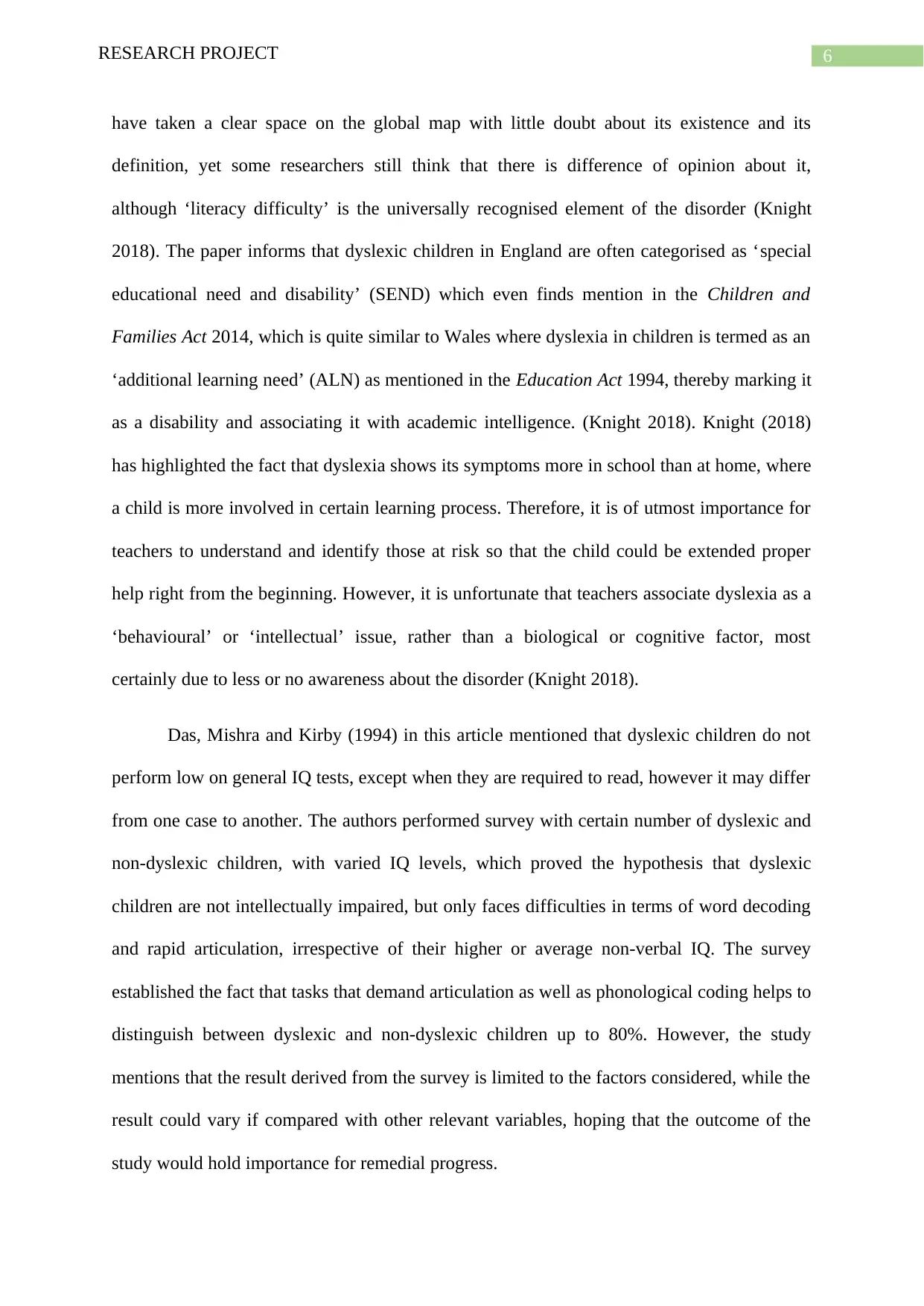
6RESEARCH PROJECT
have taken a clear space on the global map with little doubt about its existence and its
definition, yet some researchers still think that there is difference of opinion about it,
although ‘literacy difficulty’ is the universally recognised element of the disorder (Knight
2018). The paper informs that dyslexic children in England are often categorised as ‘special
educational need and disability’ (SEND) which even finds mention in the Children and
Families Act 2014, which is quite similar to Wales where dyslexia in children is termed as an
‘additional learning need’ (ALN) as mentioned in the Education Act 1994, thereby marking it
as a disability and associating it with academic intelligence. (Knight 2018). Knight (2018)
has highlighted the fact that dyslexia shows its symptoms more in school than at home, where
a child is more involved in certain learning process. Therefore, it is of utmost importance for
teachers to understand and identify those at risk so that the child could be extended proper
help right from the beginning. However, it is unfortunate that teachers associate dyslexia as a
‘behavioural’ or ‘intellectual’ issue, rather than a biological or cognitive factor, most
certainly due to less or no awareness about the disorder (Knight 2018).
Das, Mishra and Kirby (1994) in this article mentioned that dyslexic children do not
perform low on general IQ tests, except when they are required to read, however it may differ
from one case to another. The authors performed survey with certain number of dyslexic and
non-dyslexic children, with varied IQ levels, which proved the hypothesis that dyslexic
children are not intellectually impaired, but only faces difficulties in terms of word decoding
and rapid articulation, irrespective of their higher or average non-verbal IQ. The survey
established the fact that tasks that demand articulation as well as phonological coding helps to
distinguish between dyslexic and non-dyslexic children up to 80%. However, the study
mentions that the result derived from the survey is limited to the factors considered, while the
result could vary if compared with other relevant variables, hoping that the outcome of the
study would hold importance for remedial progress.
have taken a clear space on the global map with little doubt about its existence and its
definition, yet some researchers still think that there is difference of opinion about it,
although ‘literacy difficulty’ is the universally recognised element of the disorder (Knight
2018). The paper informs that dyslexic children in England are often categorised as ‘special
educational need and disability’ (SEND) which even finds mention in the Children and
Families Act 2014, which is quite similar to Wales where dyslexia in children is termed as an
‘additional learning need’ (ALN) as mentioned in the Education Act 1994, thereby marking it
as a disability and associating it with academic intelligence. (Knight 2018). Knight (2018)
has highlighted the fact that dyslexia shows its symptoms more in school than at home, where
a child is more involved in certain learning process. Therefore, it is of utmost importance for
teachers to understand and identify those at risk so that the child could be extended proper
help right from the beginning. However, it is unfortunate that teachers associate dyslexia as a
‘behavioural’ or ‘intellectual’ issue, rather than a biological or cognitive factor, most
certainly due to less or no awareness about the disorder (Knight 2018).
Das, Mishra and Kirby (1994) in this article mentioned that dyslexic children do not
perform low on general IQ tests, except when they are required to read, however it may differ
from one case to another. The authors performed survey with certain number of dyslexic and
non-dyslexic children, with varied IQ levels, which proved the hypothesis that dyslexic
children are not intellectually impaired, but only faces difficulties in terms of word decoding
and rapid articulation, irrespective of their higher or average non-verbal IQ. The survey
established the fact that tasks that demand articulation as well as phonological coding helps to
distinguish between dyslexic and non-dyslexic children up to 80%. However, the study
mentions that the result derived from the survey is limited to the factors considered, while the
result could vary if compared with other relevant variables, hoping that the outcome of the
study would hold importance for remedial progress.
Paraphrase This Document
Need a fresh take? Get an instant paraphrase of this document with our AI Paraphraser
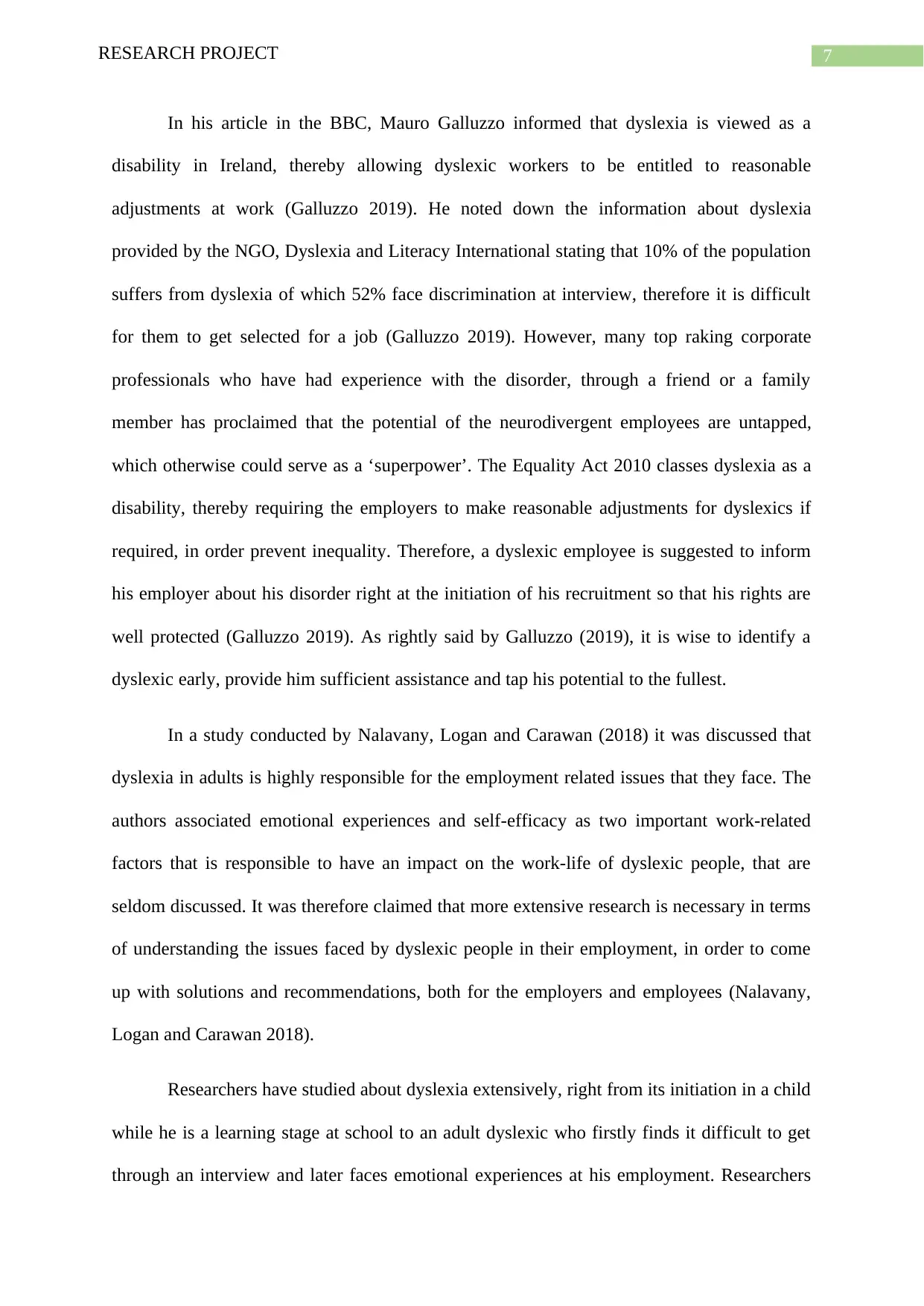
7RESEARCH PROJECT
In his article in the BBC, Mauro Galluzzo informed that dyslexia is viewed as a
disability in Ireland, thereby allowing dyslexic workers to be entitled to reasonable
adjustments at work (Galluzzo 2019). He noted down the information about dyslexia
provided by the NGO, Dyslexia and Literacy International stating that 10% of the population
suffers from dyslexia of which 52% face discrimination at interview, therefore it is difficult
for them to get selected for a job (Galluzzo 2019). However, many top raking corporate
professionals who have had experience with the disorder, through a friend or a family
member has proclaimed that the potential of the neurodivergent employees are untapped,
which otherwise could serve as a ‘superpower’. The Equality Act 2010 classes dyslexia as a
disability, thereby requiring the employers to make reasonable adjustments for dyslexics if
required, in order prevent inequality. Therefore, a dyslexic employee is suggested to inform
his employer about his disorder right at the initiation of his recruitment so that his rights are
well protected (Galluzzo 2019). As rightly said by Galluzzo (2019), it is wise to identify a
dyslexic early, provide him sufficient assistance and tap his potential to the fullest.
In a study conducted by Nalavany, Logan and Carawan (2018) it was discussed that
dyslexia in adults is highly responsible for the employment related issues that they face. The
authors associated emotional experiences and self-efficacy as two important work-related
factors that is responsible to have an impact on the work-life of dyslexic people, that are
seldom discussed. It was therefore claimed that more extensive research is necessary in terms
of understanding the issues faced by dyslexic people in their employment, in order to come
up with solutions and recommendations, both for the employers and employees (Nalavany,
Logan and Carawan 2018).
Researchers have studied about dyslexia extensively, right from its initiation in a child
while he is a learning stage at school to an adult dyslexic who firstly finds it difficult to get
through an interview and later faces emotional experiences at his employment. Researchers
In his article in the BBC, Mauro Galluzzo informed that dyslexia is viewed as a
disability in Ireland, thereby allowing dyslexic workers to be entitled to reasonable
adjustments at work (Galluzzo 2019). He noted down the information about dyslexia
provided by the NGO, Dyslexia and Literacy International stating that 10% of the population
suffers from dyslexia of which 52% face discrimination at interview, therefore it is difficult
for them to get selected for a job (Galluzzo 2019). However, many top raking corporate
professionals who have had experience with the disorder, through a friend or a family
member has proclaimed that the potential of the neurodivergent employees are untapped,
which otherwise could serve as a ‘superpower’. The Equality Act 2010 classes dyslexia as a
disability, thereby requiring the employers to make reasonable adjustments for dyslexics if
required, in order prevent inequality. Therefore, a dyslexic employee is suggested to inform
his employer about his disorder right at the initiation of his recruitment so that his rights are
well protected (Galluzzo 2019). As rightly said by Galluzzo (2019), it is wise to identify a
dyslexic early, provide him sufficient assistance and tap his potential to the fullest.
In a study conducted by Nalavany, Logan and Carawan (2018) it was discussed that
dyslexia in adults is highly responsible for the employment related issues that they face. The
authors associated emotional experiences and self-efficacy as two important work-related
factors that is responsible to have an impact on the work-life of dyslexic people, that are
seldom discussed. It was therefore claimed that more extensive research is necessary in terms
of understanding the issues faced by dyslexic people in their employment, in order to come
up with solutions and recommendations, both for the employers and employees (Nalavany,
Logan and Carawan 2018).
Researchers have studied about dyslexia extensively, right from its initiation in a child
while he is a learning stage at school to an adult dyslexic who firstly finds it difficult to get
through an interview and later faces emotional experiences at his employment. Researchers
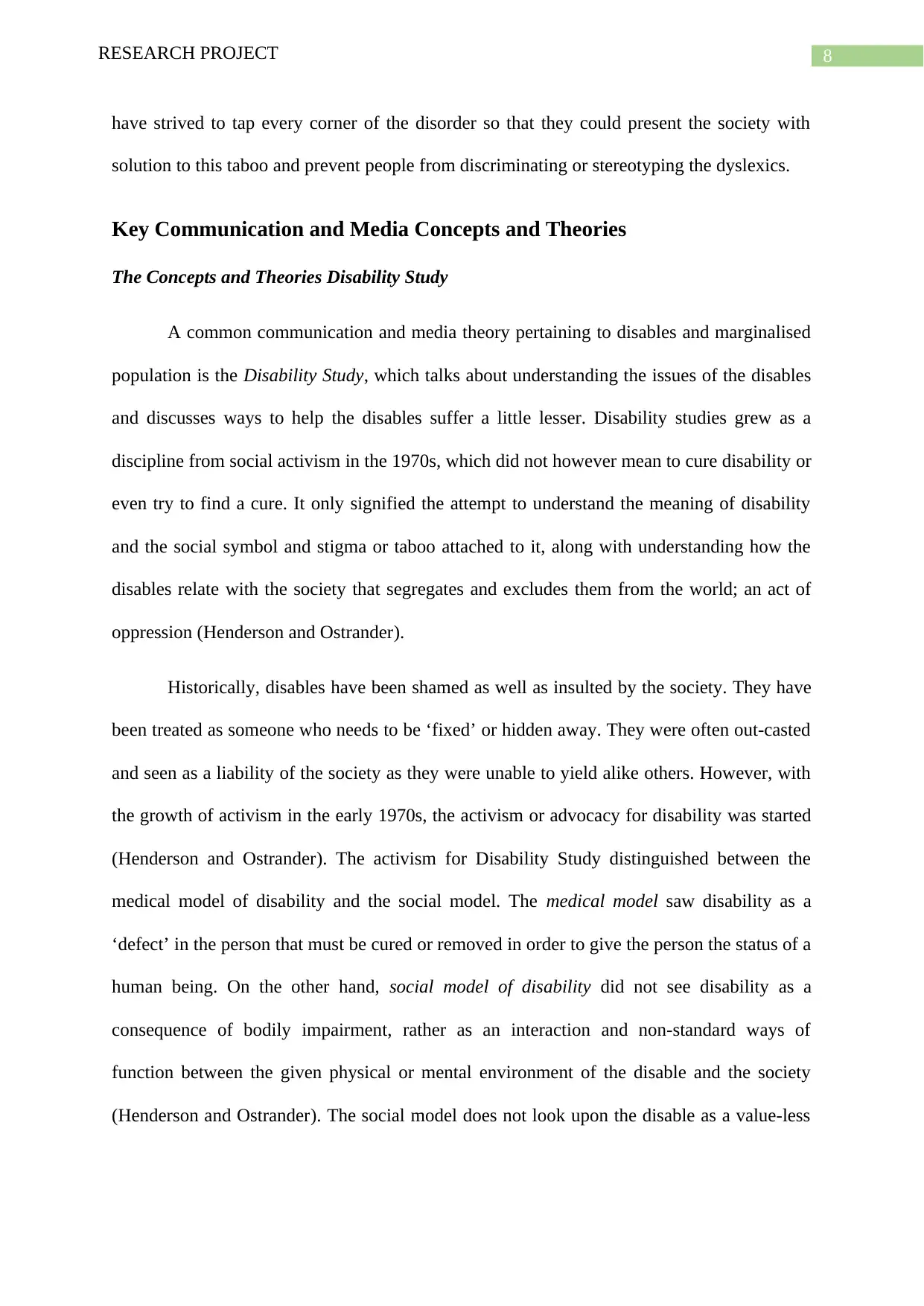
8RESEARCH PROJECT
have strived to tap every corner of the disorder so that they could present the society with
solution to this taboo and prevent people from discriminating or stereotyping the dyslexics.
Key Communication and Media Concepts and Theories
The Concepts and Theories Disability Study
A common communication and media theory pertaining to disables and marginalised
population is the Disability Study, which talks about understanding the issues of the disables
and discusses ways to help the disables suffer a little lesser. Disability studies grew as a
discipline from social activism in the 1970s, which did not however mean to cure disability or
even try to find a cure. It only signified the attempt to understand the meaning of disability
and the social symbol and stigma or taboo attached to it, along with understanding how the
disables relate with the society that segregates and excludes them from the world; an act of
oppression (Henderson and Ostrander).
Historically, disables have been shamed as well as insulted by the society. They have
been treated as someone who needs to be ‘fixed’ or hidden away. They were often out-casted
and seen as a liability of the society as they were unable to yield alike others. However, with
the growth of activism in the early 1970s, the activism or advocacy for disability was started
(Henderson and Ostrander). The activism for Disability Study distinguished between the
medical model of disability and the social model. The medical model saw disability as a
‘defect’ in the person that must be cured or removed in order to give the person the status of a
human being. On the other hand, social model of disability did not see disability as a
consequence of bodily impairment, rather as an interaction and non-standard ways of
function between the given physical or mental environment of the disable and the society
(Henderson and Ostrander). The social model does not look upon the disable as a value-less
have strived to tap every corner of the disorder so that they could present the society with
solution to this taboo and prevent people from discriminating or stereotyping the dyslexics.
Key Communication and Media Concepts and Theories
The Concepts and Theories Disability Study
A common communication and media theory pertaining to disables and marginalised
population is the Disability Study, which talks about understanding the issues of the disables
and discusses ways to help the disables suffer a little lesser. Disability studies grew as a
discipline from social activism in the 1970s, which did not however mean to cure disability or
even try to find a cure. It only signified the attempt to understand the meaning of disability
and the social symbol and stigma or taboo attached to it, along with understanding how the
disables relate with the society that segregates and excludes them from the world; an act of
oppression (Henderson and Ostrander).
Historically, disables have been shamed as well as insulted by the society. They have
been treated as someone who needs to be ‘fixed’ or hidden away. They were often out-casted
and seen as a liability of the society as they were unable to yield alike others. However, with
the growth of activism in the early 1970s, the activism or advocacy for disability was started
(Henderson and Ostrander). The activism for Disability Study distinguished between the
medical model of disability and the social model. The medical model saw disability as a
‘defect’ in the person that must be cured or removed in order to give the person the status of a
human being. On the other hand, social model of disability did not see disability as a
consequence of bodily impairment, rather as an interaction and non-standard ways of
function between the given physical or mental environment of the disable and the society
(Henderson and Ostrander). The social model does not look upon the disable as a value-less
⊘ This is a preview!⊘
Do you want full access?
Subscribe today to unlock all pages.

Trusted by 1+ million students worldwide
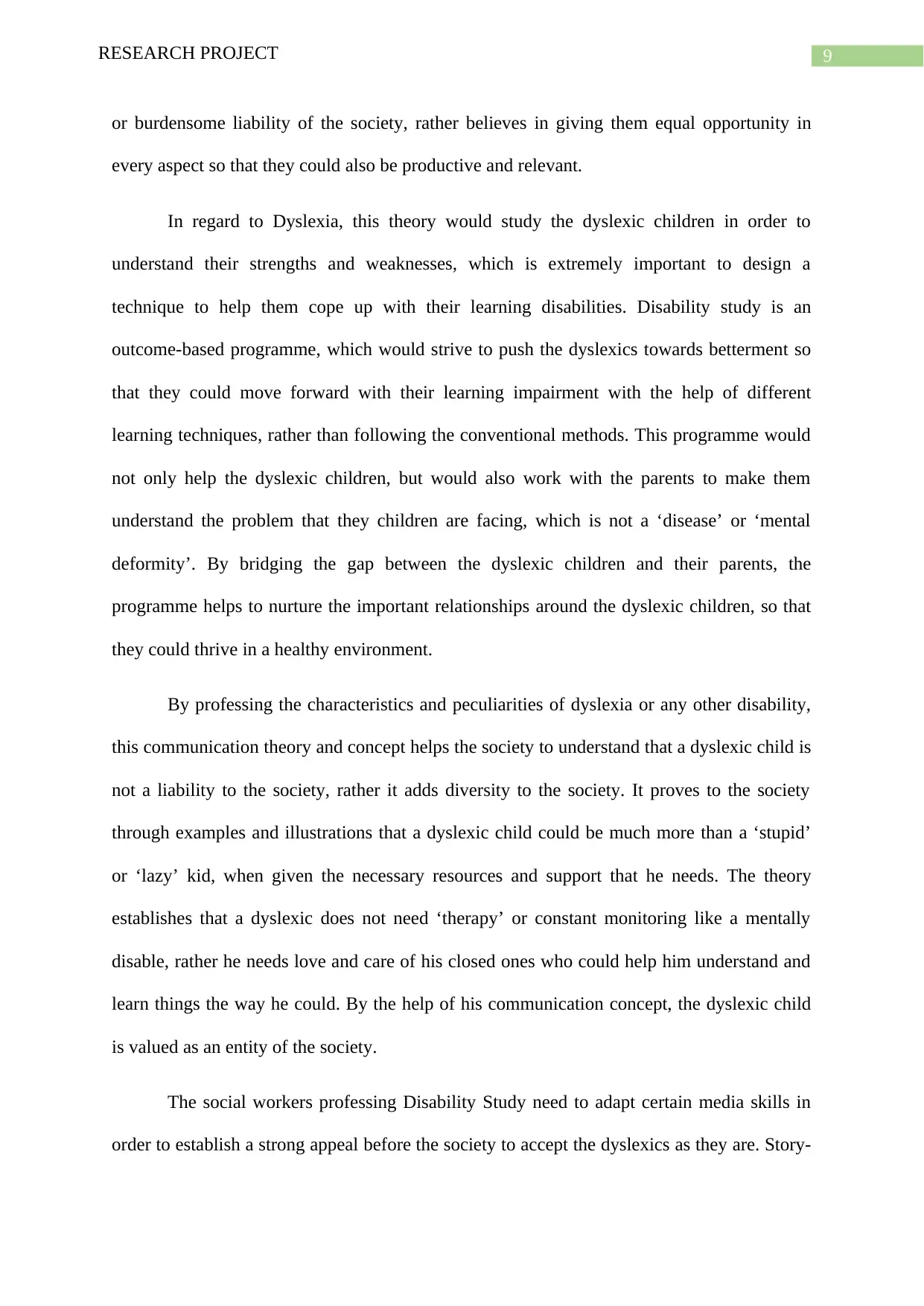
9RESEARCH PROJECT
or burdensome liability of the society, rather believes in giving them equal opportunity in
every aspect so that they could also be productive and relevant.
In regard to Dyslexia, this theory would study the dyslexic children in order to
understand their strengths and weaknesses, which is extremely important to design a
technique to help them cope up with their learning disabilities. Disability study is an
outcome-based programme, which would strive to push the dyslexics towards betterment so
that they could move forward with their learning impairment with the help of different
learning techniques, rather than following the conventional methods. This programme would
not only help the dyslexic children, but would also work with the parents to make them
understand the problem that they children are facing, which is not a ‘disease’ or ‘mental
deformity’. By bridging the gap between the dyslexic children and their parents, the
programme helps to nurture the important relationships around the dyslexic children, so that
they could thrive in a healthy environment.
By professing the characteristics and peculiarities of dyslexia or any other disability,
this communication theory and concept helps the society to understand that a dyslexic child is
not a liability to the society, rather it adds diversity to the society. It proves to the society
through examples and illustrations that a dyslexic child could be much more than a ‘stupid’
or ‘lazy’ kid, when given the necessary resources and support that he needs. The theory
establishes that a dyslexic does not need ‘therapy’ or constant monitoring like a mentally
disable, rather he needs love and care of his closed ones who could help him understand and
learn things the way he could. By the help of his communication concept, the dyslexic child
is valued as an entity of the society.
The social workers professing Disability Study need to adapt certain media skills in
order to establish a strong appeal before the society to accept the dyslexics as they are. Story-
or burdensome liability of the society, rather believes in giving them equal opportunity in
every aspect so that they could also be productive and relevant.
In regard to Dyslexia, this theory would study the dyslexic children in order to
understand their strengths and weaknesses, which is extremely important to design a
technique to help them cope up with their learning disabilities. Disability study is an
outcome-based programme, which would strive to push the dyslexics towards betterment so
that they could move forward with their learning impairment with the help of different
learning techniques, rather than following the conventional methods. This programme would
not only help the dyslexic children, but would also work with the parents to make them
understand the problem that they children are facing, which is not a ‘disease’ or ‘mental
deformity’. By bridging the gap between the dyslexic children and their parents, the
programme helps to nurture the important relationships around the dyslexic children, so that
they could thrive in a healthy environment.
By professing the characteristics and peculiarities of dyslexia or any other disability,
this communication theory and concept helps the society to understand that a dyslexic child is
not a liability to the society, rather it adds diversity to the society. It proves to the society
through examples and illustrations that a dyslexic child could be much more than a ‘stupid’
or ‘lazy’ kid, when given the necessary resources and support that he needs. The theory
establishes that a dyslexic does not need ‘therapy’ or constant monitoring like a mentally
disable, rather he needs love and care of his closed ones who could help him understand and
learn things the way he could. By the help of his communication concept, the dyslexic child
is valued as an entity of the society.
The social workers professing Disability Study need to adapt certain media skills in
order to establish a strong appeal before the society to accept the dyslexics as they are. Story-
Paraphrase This Document
Need a fresh take? Get an instant paraphrase of this document with our AI Paraphraser
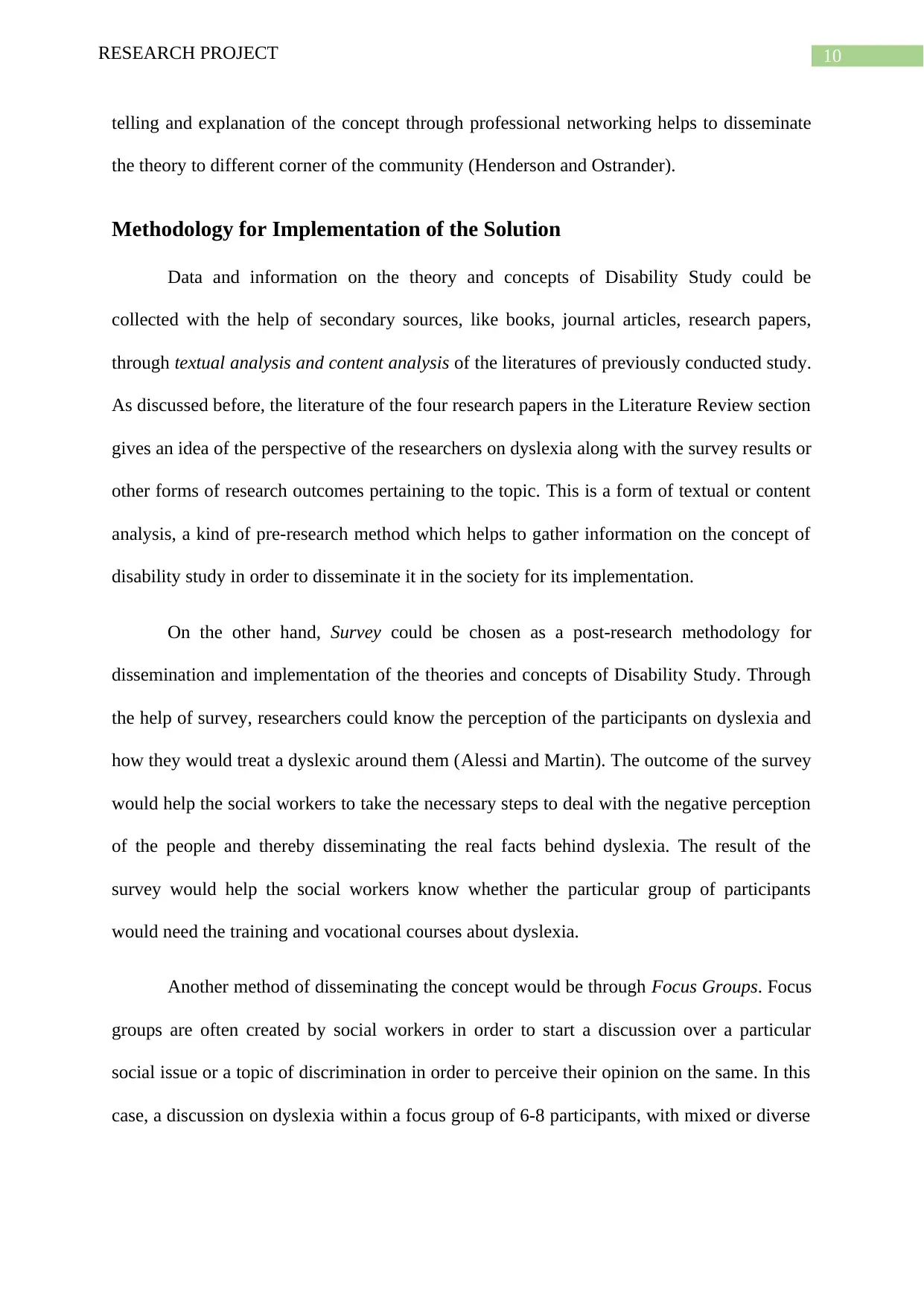
10RESEARCH PROJECT
telling and explanation of the concept through professional networking helps to disseminate
the theory to different corner of the community (Henderson and Ostrander).
Methodology for Implementation of the Solution
Data and information on the theory and concepts of Disability Study could be
collected with the help of secondary sources, like books, journal articles, research papers,
through textual analysis and content analysis of the literatures of previously conducted study.
As discussed before, the literature of the four research papers in the Literature Review section
gives an idea of the perspective of the researchers on dyslexia along with the survey results or
other forms of research outcomes pertaining to the topic. This is a form of textual or content
analysis, a kind of pre-research method which helps to gather information on the concept of
disability study in order to disseminate it in the society for its implementation.
On the other hand, Survey could be chosen as a post-research methodology for
dissemination and implementation of the theories and concepts of Disability Study. Through
the help of survey, researchers could know the perception of the participants on dyslexia and
how they would treat a dyslexic around them (Alessi and Martin). The outcome of the survey
would help the social workers to take the necessary steps to deal with the negative perception
of the people and thereby disseminating the real facts behind dyslexia. The result of the
survey would help the social workers know whether the particular group of participants
would need the training and vocational courses about dyslexia.
Another method of disseminating the concept would be through Focus Groups. Focus
groups are often created by social workers in order to start a discussion over a particular
social issue or a topic of discrimination in order to perceive their opinion on the same. In this
case, a discussion on dyslexia within a focus group of 6-8 participants, with mixed or diverse
telling and explanation of the concept through professional networking helps to disseminate
the theory to different corner of the community (Henderson and Ostrander).
Methodology for Implementation of the Solution
Data and information on the theory and concepts of Disability Study could be
collected with the help of secondary sources, like books, journal articles, research papers,
through textual analysis and content analysis of the literatures of previously conducted study.
As discussed before, the literature of the four research papers in the Literature Review section
gives an idea of the perspective of the researchers on dyslexia along with the survey results or
other forms of research outcomes pertaining to the topic. This is a form of textual or content
analysis, a kind of pre-research method which helps to gather information on the concept of
disability study in order to disseminate it in the society for its implementation.
On the other hand, Survey could be chosen as a post-research methodology for
dissemination and implementation of the theories and concepts of Disability Study. Through
the help of survey, researchers could know the perception of the participants on dyslexia and
how they would treat a dyslexic around them (Alessi and Martin). The outcome of the survey
would help the social workers to take the necessary steps to deal with the negative perception
of the people and thereby disseminating the real facts behind dyslexia. The result of the
survey would help the social workers know whether the particular group of participants
would need the training and vocational courses about dyslexia.
Another method of disseminating the concept would be through Focus Groups. Focus
groups are often created by social workers in order to start a discussion over a particular
social issue or a topic of discrimination in order to perceive their opinion on the same. In this
case, a discussion on dyslexia within a focus group of 6-8 participants, with mixed or diverse
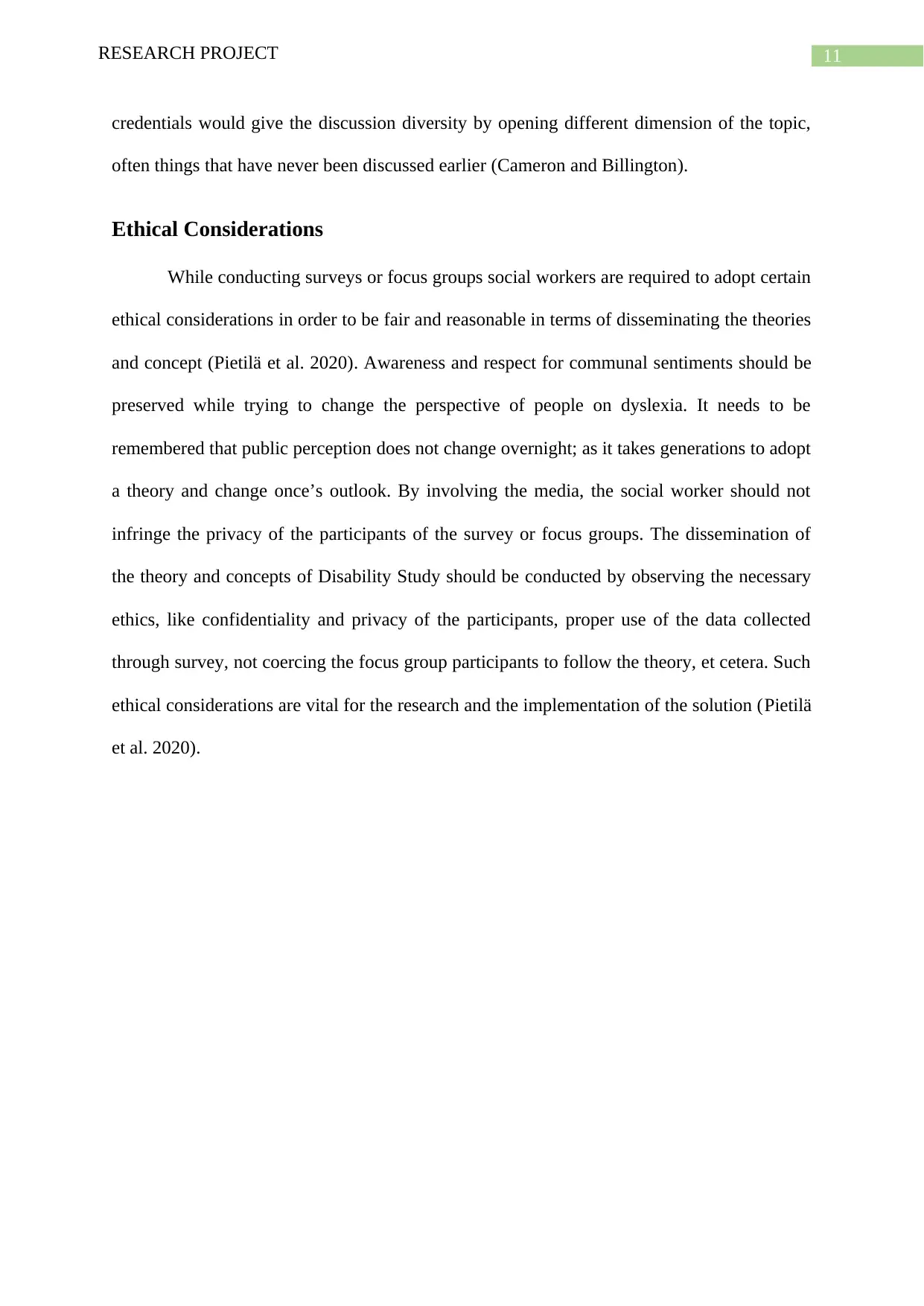
11RESEARCH PROJECT
credentials would give the discussion diversity by opening different dimension of the topic,
often things that have never been discussed earlier (Cameron and Billington).
Ethical Considerations
While conducting surveys or focus groups social workers are required to adopt certain
ethical considerations in order to be fair and reasonable in terms of disseminating the theories
and concept (Pietilä et al. 2020). Awareness and respect for communal sentiments should be
preserved while trying to change the perspective of people on dyslexia. It needs to be
remembered that public perception does not change overnight; as it takes generations to adopt
a theory and change once’s outlook. By involving the media, the social worker should not
infringe the privacy of the participants of the survey or focus groups. The dissemination of
the theory and concepts of Disability Study should be conducted by observing the necessary
ethics, like confidentiality and privacy of the participants, proper use of the data collected
through survey, not coercing the focus group participants to follow the theory, et cetera. Such
ethical considerations are vital for the research and the implementation of the solution (Pietilä
et al. 2020).
credentials would give the discussion diversity by opening different dimension of the topic,
often things that have never been discussed earlier (Cameron and Billington).
Ethical Considerations
While conducting surveys or focus groups social workers are required to adopt certain
ethical considerations in order to be fair and reasonable in terms of disseminating the theories
and concept (Pietilä et al. 2020). Awareness and respect for communal sentiments should be
preserved while trying to change the perspective of people on dyslexia. It needs to be
remembered that public perception does not change overnight; as it takes generations to adopt
a theory and change once’s outlook. By involving the media, the social worker should not
infringe the privacy of the participants of the survey or focus groups. The dissemination of
the theory and concepts of Disability Study should be conducted by observing the necessary
ethics, like confidentiality and privacy of the participants, proper use of the data collected
through survey, not coercing the focus group participants to follow the theory, et cetera. Such
ethical considerations are vital for the research and the implementation of the solution (Pietilä
et al. 2020).
⊘ This is a preview!⊘
Do you want full access?
Subscribe today to unlock all pages.

Trusted by 1+ million students worldwide
1 out of 14
Related Documents
Your All-in-One AI-Powered Toolkit for Academic Success.
+13062052269
info@desklib.com
Available 24*7 on WhatsApp / Email
![[object Object]](/_next/static/media/star-bottom.7253800d.svg)
Unlock your academic potential
Copyright © 2020–2025 A2Z Services. All Rights Reserved. Developed and managed by ZUCOL.




